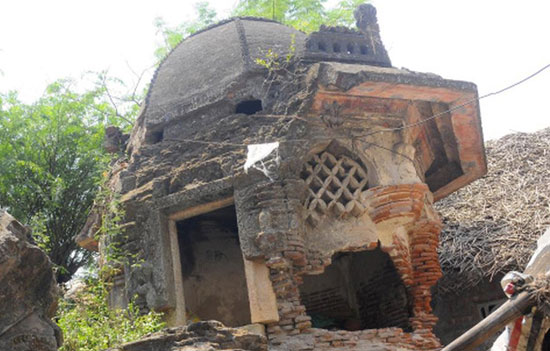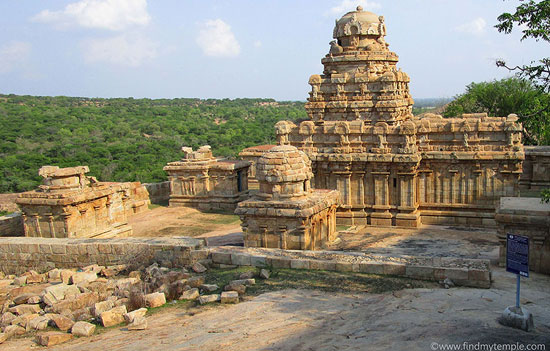- Read about the inspiring battle fought by King
Vijayalaya Chola in the 9th century.
Like all other children who were in school during the 70's and 80's, I grew up believing the only great empire India had was the Mughal Empire. My husband, Krishnan had read about the Cholas, Pallavas, Pandiyas etc but I had no exposure to those empires. I had just read that there was a Chola Empire and knew no more. Vijayalaya may be assigned to the period 850-871 A.D.
Kalki Krishnamurthy, Chola
Empire and Ponniyin Selvan
I can read and write Tamil correctly but painfully slowly ... so I never managed to read the modern classics in Tamil literature. While browsing Kindle Unlimited, I chanced upon the English translation of Kalki Krishnamurthy's Ponniyin Selvan Book 1, by Pavithra Srinivasan and immediately started reading it. This is a huge series of novels written as weekly magazine columns and later made into five volumes.
It is un-put-downable. Pavithra Srinivasan
has done an outstanding job of the translation. While it is a fictional account
of the greatest Chola emperor, Raja Raja Chola’s (Arulmozhi Varmar) life, the
historical events are factual. One such historical event is the battle between
Pandiyas and Pallavas in the northern part of River Kollidam (a tributary of
River Kaveri).
Ganga King Prithvipathi and Aditha Chozha (in
Tamil called Chozha, in English Chola) fought along with Pallavas to defend
their (then) tiny Kingdom from being taken over by the Pandiyas. The following
is an excerpt of how the battle was won from the brink of a crushing loss. The
words are, of course fictional, but the events are facts. This is from Book 1
of Ponniyin Selvan.
".... A hasty conference was held in Aparajitha Varman’s tent: the Pallava King, Prithvipathi of the Ganga kingdom and Aditha Chozha huddled together to discuss the next course of action. It was obvious that they could not hold out for long; a retreat to the northern banks of the River Kollidam stared them in the face.
And then - a miracle occurred.
Vijayalaya Chozha, scarred with endless
wounds from battle, practically bed-ridden with infirmity and almost unable to
stand on legs riddled with injuries-had somehow managed to arrive onto the
battlefield. Should the Pallavas ever retreat to the north of the Kollidam, the
Chozhas were doomed; it would be centuries before there would be any hope of
regaining their lost glory.
Well aware of these circumstances, the old
battle-hardened lion had arrived on the battlefield-and now, growled a
ferocious oath that lent new life to the faltering Pallava warriors.
“An elephant-give me an elephant!” he
pleaded. “They have been completely decimated; we have none left,” came the
answer.
“A horse then-just one horse!” “There are
none alive,” was the depressed reply.
“Does Chozha Nadu possess at least two
true warriors?” cried Vijayalaya, desperate.
Two hundred answered his clarion
call.
“Two-two of you, who possess a warrior’s
heart and strength, may hoist me onto your shoulders and march into battle. The
rest-follow us in twos,” commanded that warrior among warriors.
“Should the men who bear me fall, the ones
behind them shall carry me, in turn!”
Thus, two soldiers, each with the height
and build of the famed Pandava wrestler Bheemasena, promptly stepped forward
and hoisted Vijayalaya onto their shoulders.
“Now! Carry me to the battle, now!” roared
the man.
Battle still raged furiously in a corner
of the field; the marava warriors of
the southern lands were engaged in beating back the eastern soldiers.
Vijayalaya Chozha thus entered the battlefield, to almost certain defeat. He
marched in on the shoulders of two men, bearing a gleaming sword in each hand,
twirling it around like Thirumaal wielding his discus with supreme
confidence.
He ploughed through enemy ranks, lopping
of their heads without pause or hesitation; no one, it seemed, could stop him.
And yes-his incredible courage had its effect: soldiers, who had hitherto
withdrawn, fatigued with battled, now began to creep forward.
They stood still, gaping at Vijayalaya’s
almost inhuman strength and valour. Slowly, they encouraged each other, patted
each other’s backs-and began to enter the battlefield with renewed vim and
vigour.
In an instant, Jayalakshmi, the Goddess of
Victory, had turned her compassionate gaze towards the advancing warriors. The
Pallava commanders gave up their decision to retreat towards the north of
Kollidam. The three kings now joined together, along with their personal
regiments and re-entered the battlefield with new strength.
Their concentrated attack had its effect:
the Pandiya soldiers fell back in retreat, and turned their backs, stopping
only until they reached the frontiers of their own kingdom.
It was in this battle that the Ganga king, Prithvipathi embraced death, having performed a great many valorous deeds. His men raised a memorial stone in his honour and later, a pallipadai as well." Note that Pallipadai is a
small temple or war memorial raised for heroic warriors. The Pallipadai built
for Ganga King Prithvipathi is in ruins but is still there. That itself is
proof of this incident.
 Pallipadai of King Prithvipathi.
Pallipadai of King Prithvipathi.
I don't know about you, but I have goose bumps reading about Vijayalaya Chola! How awe inspiring he is - snatching a victory from the jaws of defeat. This is the history that our children must read, not about drug addiction, harems and eunuchs that the sick Mughal rulers favoured.
Vijayalaya Chozha re-energized and
re-established the Chola Empire. The ancient Chola Empire finds mention in the
inscriptions during emperor Ashoka’s reign. For two to three centuries, the
Pallavas and Pandiyas were ruling over large parts of Tamil Nadu, Sri Lanka and
many Southeast Asian islands. With Vijayalaya Chozha the medieval Chola Empire
starts from 9th Century CE.
 Vijayalaya Choleeshwaram temple
renovated by Vijayalaya Chola.
Vijayalaya Choleeshwaram temple
renovated by Vijayalaya Chola.
The Cholas are amongst the longest ruling
dynasties in the world-nearly 1600 years. Inscriptions from the Mauryan Empire
(3rd Century BCE) mention about the early Cholas. The medieval Cholas starting
from Vijayalaya Chola ruled all the way till 1279 CE.
Maldives, Nicobar Islands, Parts of modern
day Myanmar, Malaysia, Indonesia (Sri Vijaya), Philippines, Thailand, Vietnam,
Cambodia (Kamboj), Laos, Sri Lanka were all part of the Chola Empire at one
time or the other.
Krishnan and I visited Laos in 2016 and
the Laotian language has its roots in Tamil.
Korean language similarly shares nearly 400+ words with the Tamil language.
The influence of the Chola Empire hasn’t
been studied in full. Some of the Sangam era copper plates etc. are yet to be
deciphered. I wonder what we may find in those… Copper plates with inscriptions
from Raja Raja Chola (Arul Mozhi Varmar)’s time are kept in the Leiden Museum,
Netherlands. Hopefully they return home soon.
Author is an Executive Coach, Co-founder www.Shikshadaan.com and blogs at www.90rollsroyces.com
To read all
articles by author
Also read
1. Pritvipathi
About and Battle
2. Brief
history of the Cholas
3. All
you wanted to know about the Cholas
4.
Vijayalaya
Choleeshwar Temple